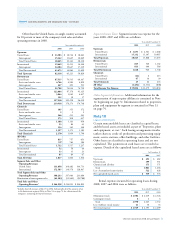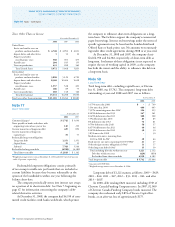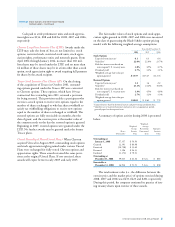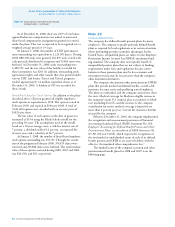Chevron 2008 Annual Report Download - page 77
Download and view the complete annual report
Please find page 77 of the 2008 Chevron annual report below. You can navigate through the pages in the report by either clicking on the pages listed below, or by using the keyword search tool below to find specific information within the annual report.
Chevron Corporation 2008 Annual Report 75
Note 15
Litigation
MTBE Chevron and many other companies in the petroleum
industry have used methyl tertiary butyl ether (MTBE) as a
gasoline additive. In October 2008, 59 cases were settled in
which the company was a party and which related to the use
of MTBE in certain oxygenated gasolines and the alleged
seepage of MTBE into groundwater. The terms of this agree-
ment are confidential and not material to the company’s
results of operations, liquidity or financial position.
Chevron is a party to 37 other pending lawsuits and
claims, the majority of which involve numerous other petro-
leum marketers and refiners. Resolution of these lawsuits
and claims may ultimately require the company to correct
or ameliorate the alleged effects on the environment of prior
release of MTBE by the company or other parties. Additional
lawsuits and claims related to the use of MTBE, including
personal-injury claims, may be filed in the future. The settle-
ment of the 59 lawsuits did not set any precedents related
to standards of liability to be used to judge the merits of the
claims, corrective measures required or monetary damages to
be assessed for the remaining lawsuits and claims or future
lawsuits and claims. As a result, the company’s ultimate
exposure related to pending lawsuits and claims is not cur-
rently determinable, but could be material to net income in
any one period. The company no longer uses MTBE in the
manufacture of gasoline in the United States.
RFG Patent Fourteen purported class actions were brought
by consumers who purchased reformulated gasoline (RFG)
from January 1995 through August 2005, alleging that
Unocal misled the California Air Resources Board into
adopting standards for composition of RFG that overlapped
with Unocal’s undisclosed and pending patents. The parties
agreed to a settlement that calls for, among other things,
Unocal to pay $48 and for the establishment of a cy pres fund
to administer payout of the award. The court approved the
final settlement in November 2008.
Ecuador Chevron is a defendant in a civil lawsuit before
the Superior Court of Nueva Loja in Lago Agrio, Ecua-
dor, brought in May 2003 by plaintiffs who claim to be
representatives of certain residents of an area where an oil
production consortium formerly had operations. The lawsuit
alleges damage to the environment from the oil exploration
and production operations, and seeks unspecified damages
to fund environmental remediation and restoration of the
alleged environmental harm, plus a health monitoring pro-
gram. Until 1992, Texaco Petroleum Company (Texpet),
a subsidiary of Texaco Inc., was a minority member of this
consortium with Petroecuador, the Ecuadorian state-owned
oil company, as the majority partner; since 1990, the
operations have been conducted solely by Petroecuador.
At the conclusion of the consortium and following an
independent third-party environmental audit of the con-
cession area, Texpet entered into a formal agreement with
the Republic of Ecuador and Petroecuador for Texpet to
remediate specific sites assigned by the government in
proportion to Texpet’s ownership share of the consor-
tium. Pursuant to that agreement, Texpet conducted a
three-year remediation program at a cost of $40. After
certifying that the sites were properly remediated, the gov-
ernment granted Texpet and all related corporate entities a
full release from any and all environmental liability arising
from the consortium operations.
Based on the history described above, Chevron
believes that this lawsuit lacks legal or factual merit. As to
matters of law, the company believes first, that the court
lacks jurisdiction over Chevron; second, that the law
under which plaintiffs bring the action, enacted in 1999,
cannot be applied retroactively to Chevron; third, that the
claims are barred by the statute of limitations in Ecuador;
and, fourth, that the lawsuit is also barred by the releases
from liability previously given to Texpet by the Republic
of Ecuador and Petroecuador. With regard to the facts,
the company believes that the evidence confirms that
Texpet’s remediation was properly conducted and that the
remaining environmental damage reflects Petroecuador’s
failure to timely fulfill its legal obligations and Petroecua-
dor’s further conduct since assuming full control over the
operations.
In April 2008, a mining engineer appointed by the
court to identify and determine the cause of environ-
mental damage, and to specify steps needed to remediate
it, issued a report recommending that the court assess
$8,000, which would, according to the engineer, provide
financial compensation for purported damages, including
wrongful death claims, and pay for, among other items,
environmental remediation, health care systems, and
additional infrastructure for Petroecuador. The engineer’s
report also asserted that an additional $8,300 could be
assessed against Chevron for unjust enrichment. The
engineer’s report is not binding on the court. Chevron
also believes that the engineer’s work was performed and
his report prepared in a manner contrary to law and in
violation of the court’s orders. Chevron submitted a rebut-
tal to the report in which it asked the court to strike the
report in its entirety. In November 2008, the engineer
revised the report and, without additional evidence, rec-
ommended an increase in the financial compensation for
purported damages to a total of $18,900 and an increase
in the assessment for purported unjust enrichment to a
























